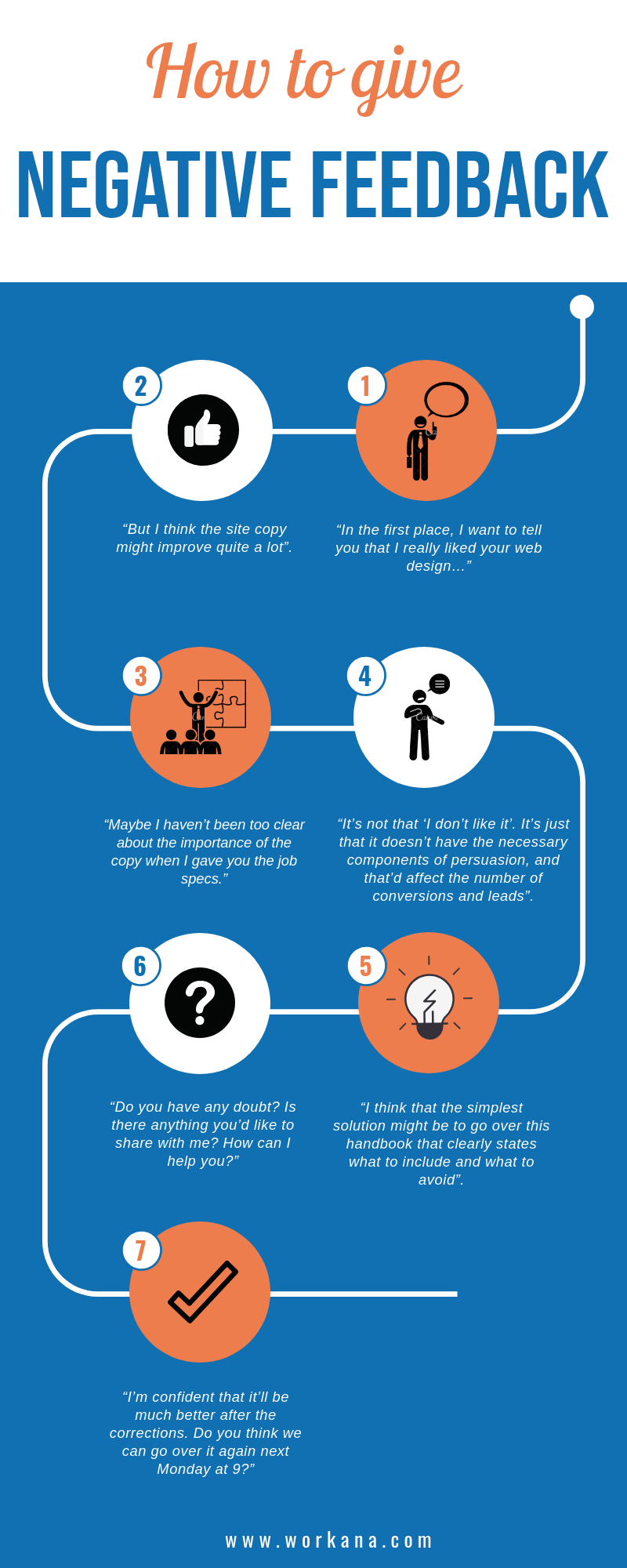As well as being a freelancer, I work as a labor psychologist, and I become a businesswoman whenever I need to count on a remote work team for large projects (which happens pretty often) plus I’m a partner to Workana, the largest freelance working platform of Latin America.
If there is anything I’ve learned out of all this is that giving negative feedback when you work with other freelancers might be hard –though I’ve also learned the best way to do so.
I’ve been there myself, as a freelancer, as a client and also from the viewpoint of behavioural and cognitive “science” behind the success or failure of feedback. Besides, Workana has gathered insightful information along the years about the dynamics of messages on the platform and how feedback manners have an impact on the final result of the project.
In conclusion, we’ve put together a very useful guide which is focused on giving negative feedback to your freelancers in the most assertive way, granting the best results.
The advantages of timely, assertive feedback are many, among them:
- Increasing work quality.
- Saving resources such as time and money.
- Improving communication and trust among the parties.
On the other hand, bad feedback might lead to an unwanted outcome –spoiling the project results or even the working relationship. Let’s start with a short explanation about some of them and then we’ll go on with seven very specific strategies to provide good negative feedback to a freelancer and getting the most of your project.
The three worst results of bad feedback
Not providing feedback, or doing so just to praise achievements, or else, just to focus on mistakes, is bad news. But providing bad feedback, either positive or negative, is far worse. At this point, it’d be smart to get this straight to avoid future confusion:
- Good feedback: It serves its purpose, mistakes are amended or expected results are archieved, and it doesn’t have a negative psychological impact on the freelancer.
- Bad feedback: It doesn’t contribute to an amendment or to the achievement of expected results, and/or it has a negative psychological impact on the freelancer.
- Positive feedback: It refers to the acknowledgement of the success and achievements of a worker.
- Negative feedback: It refers to the feedback about the mistakes and improvement areas.
Bad feedback results in endless unwanted consequences, but most of them can be summerized in three main scenarios:
Consequence N°1: Building resistance
Resistance has to do with the unwillingness to embrace the responsibility of an improvement area. In other words, the freelancer considers that they are not accountable for the mistake or problem but it’s someone else’s fault –perhaps the client’s or the situation.
Rick Maurer, well-known advisor and writer on topics such as business leadership for positive change, describes on his book Beyond the walls of resistance the main forms that resistance may take in a partner when it’s time for feedback:
- “I don’t get it”: Sometimes, the partner actually can’t see where the mistake is or why we’re asking for a correction, since we might have not been clear enough. But within this resistance dimension, “I don’t get it” may have to do with some element of our feedback which leads them to a cognitive block and to “decide” not to see the problem.
- “I don’t like it”: It appears mainly when feedback is sensed as a personal threat and so it causes a defensive attitude. The problem with this sort of resistance is that the interest focus shifts from the facts to the emotional state, preventing to solve the problem objectively.
- “I don’t trust you”: We’re usually more inclined to believe someone we like rather than someone we mistrust or we dislike, even if the information provided is exactly the same. If the recipient of our feedback does not trust the person who provides it, they won’t believe that feedback is fair or relevant.
Consequence N°2: Affecting the self-confidence of the employee
Keeping a balance on employee self-confidence is key to providing good feedback. Bad negative feedback might undermine their self-confidence, and bad positive feedback might swell it out –and both situations are detrimental to performance.
In the first case, the partner will feel so insecure that anxiety and stress will affect their performance. In the second case, they will be so confident of doing a great job that they might be reluctant to welcome any future suggestions for improvement and to consider those as a misperception from their client.
This chart helps us understand how the relationship between self-confidence and performance works:

Consequence N°3: The mistake remains
If feedback does not lead to an agreement or if it’s very unspecific, we’re not providing the freelancer with the necessary tools or motivation to understand how, where and why we require a change, and mostly, how to apply it properly.
When our feedback does not meet its purpose, freelancer and client waste their time and energy, the relationship between them gets eroded and both grow unsatisfied with the project results.
Resistance, threat to self-confidence and remaining mistakes can be avoided by taking into account some assertive triggers which help cope with stress and create an environment of assurance and confidence. These triggers include the following:
7 steps to good negative feedback
As you can see, bad feedback might be devastating. Fortunately, there are seven steps (a sort of “checklist”) that allow you to tackle with every important elements of good negative feedback from beginning to end, and in the right order.
1.- Start with something positive about their job: A strong point or something that they have excelled at. Here you’ll build positive emotional readiness to increase their responsiveness and their willingness to improve.
2.- Put the problem into positive terms: It’s better to say “You can improve on this” than “You’re wrong on this”. Even when they mean the same thing, the brain interprets both statements very differently as the first approach underlines the opportunity to improve whereas the second approach focuses on a past mistake which cannot be changed.
3.- State clearly how that situation impacts the performance or results of the project: If you don’t explain why a mistake is a mistake, it’s possible that feedback is sensed as subjective criticism.
4.- Hold accountable for the problem, if you have to: Many times, mistakes are based on shared responsibility. If that is the case, hold accountable and acknowledge your share of the blame.
5.- Offer realistic and measurable solutions: Before providing feedback, consider the instructions and tools you’re about to offer in order to solve the problem.
6.- Welcome open dialogue: Make sure that the message you meant to convey has been perfectly understood and that all doubts have been removed, and that the employee feels confident enough to speak their own mind.
7.- Conclude with positive motivation and an agreement: The conclusion has to state clearly that you trust the skills of the employee and that you respect the compromise you’ve come to.
Here you can see an example of how to apply this technique. The graphics show a good negative feedback dialogue held with a freelancer:

In conclusion…
The ability to provide good negative feedback is an essential ability you need to acquire in order to best work with remote work teams or freelancers.
It’s not just about a strategy to substantially improve your project results but a habit that will let you build trust-worthy, long-term relationships with your favorite freelancers. As a result, the quality of their work will get increasingly better.
At Workana we connect you to thousands of highly-qualified independent professionals to help your company grow as quickly and efficiently as possible.
We have a resounding success on our projects, based on building a solid culture of remote work, which includes providing you with the tools to give outstanding negative feedback to your partners.
For further keys to good feedback, you can access our blog.
Assul





